Abstract
Aspartylglucosaminidase (AGA) is a lysosomal asparaginase that participates in the breakdown of glycoproteins by cleaving the amide bond between the asparagine and the oligosaccharide chain. Active AGA is an (alphabeta)2 heterotetramer of two non-identical subunits that are cleaved proteolytically from an enzymatically inactive precursor polypeptide. On the basis of the three-dimensional structure recently determined by us, we have here mutagenized the putative active site amino acids of AGA and studied by transient expression the effect of targeted substitutions on the enzyme activity and catalytic properties of AGA. These analyses support the novel type of catalytic mechanism, suggested previously by us, in which AGA utilizes as the nucleophile the N-terminal residue of the beta subunit and most importantly its alpha-amino group as a base that increases the nucleophilicity of the OH group. We also provide evidence for autocatalytic activation of the inactive AGA precursor and putative involvement of active site amino acids in the proteolytic processing. The data obtained on the structure and function of AGA would indicate that AGA is a member of a recently described novel class of hydrolytic enzymes (amidohydrolases) sharing a common structural determinant in their three-dimensional structure and whose catalytic mechanisms with an N-terminal nucleophile seem basically to be similar.
Full text
PDF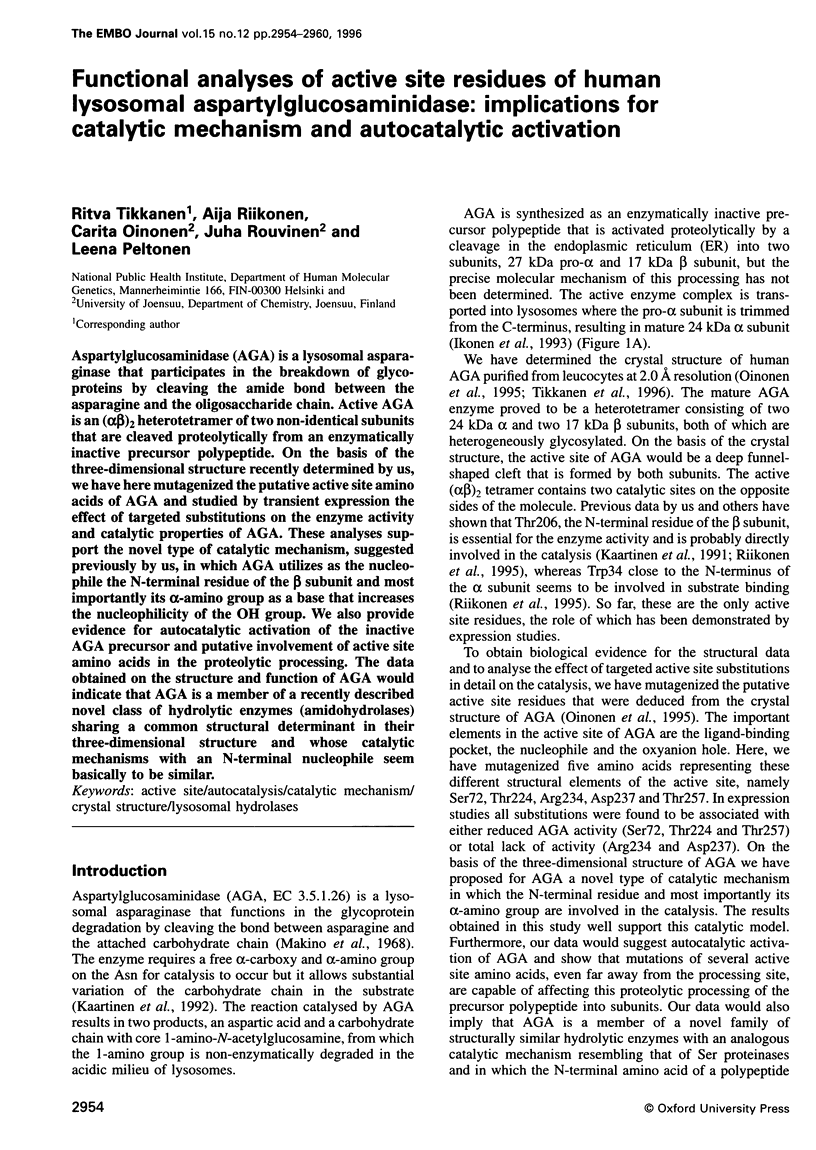
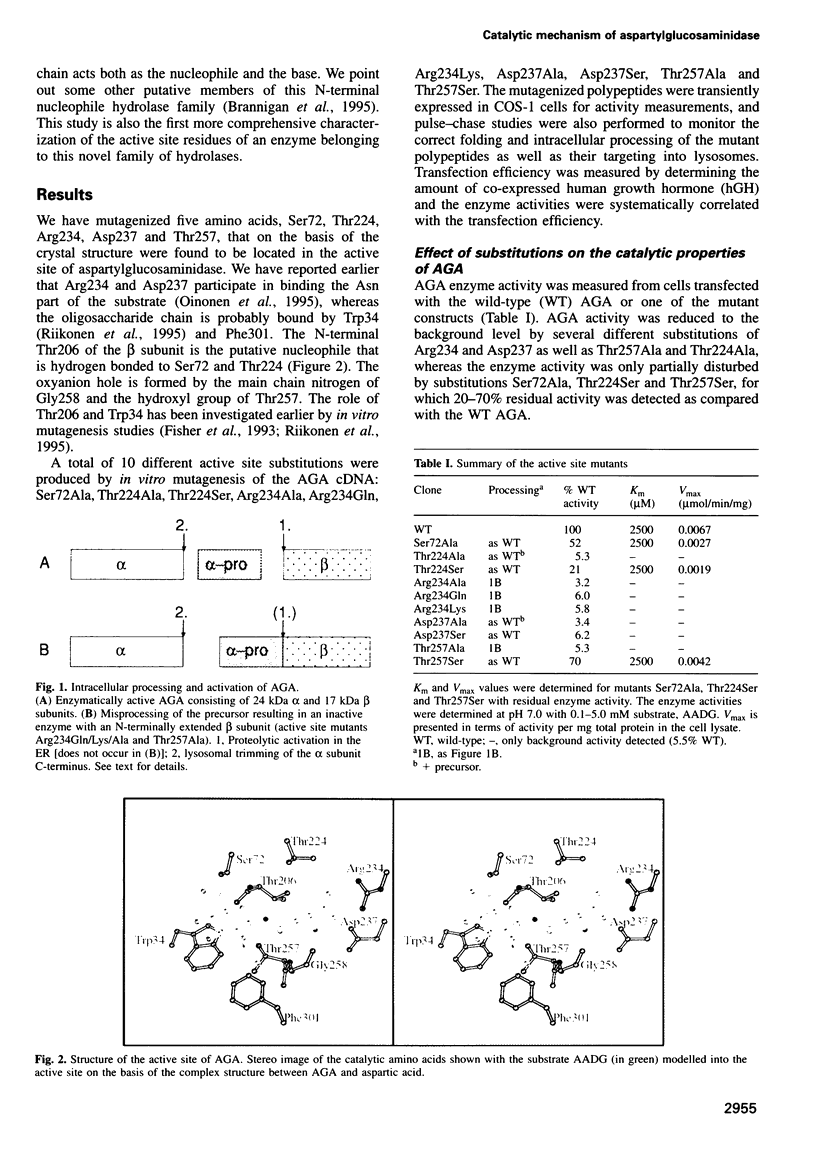
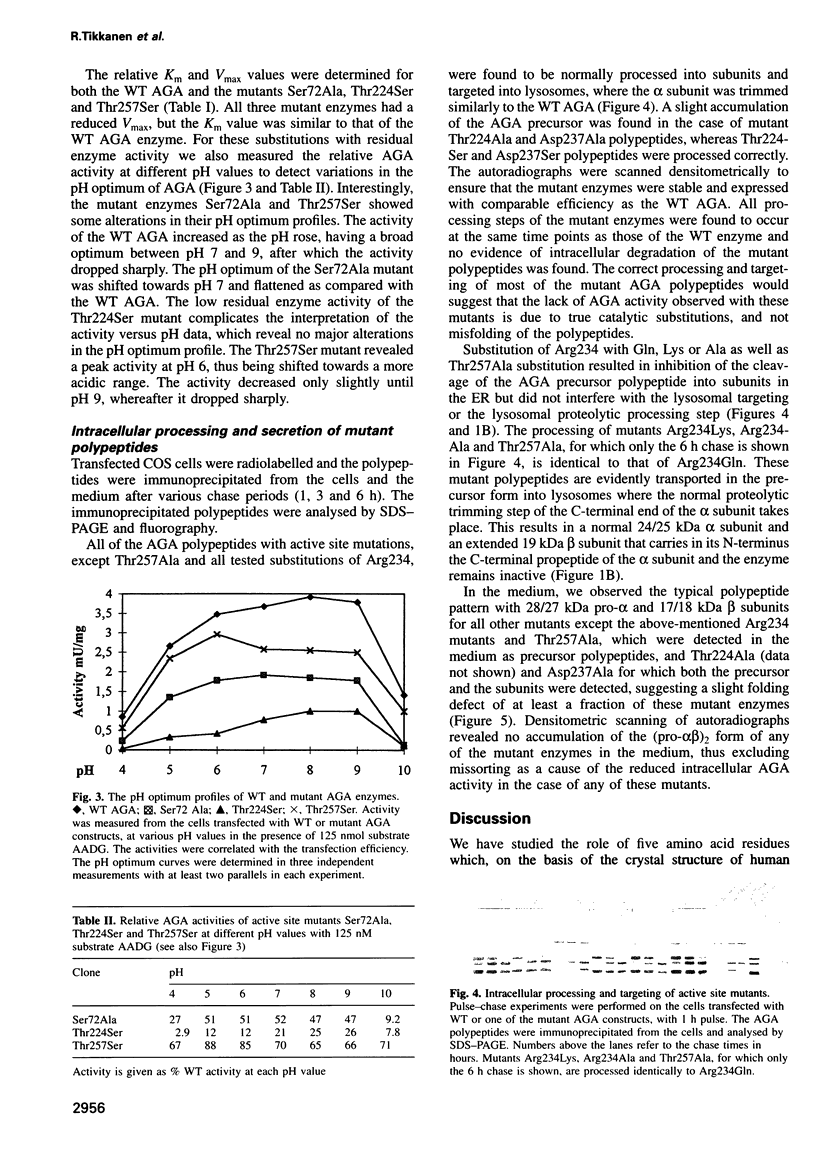
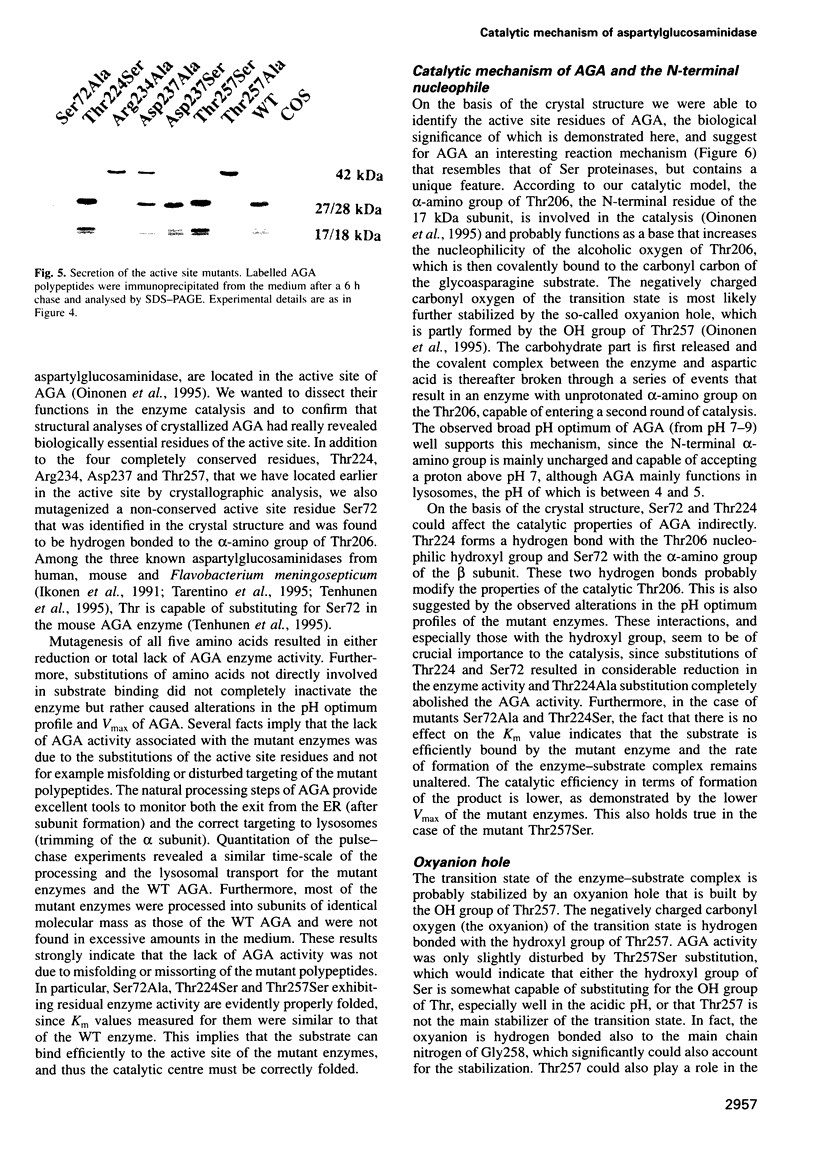
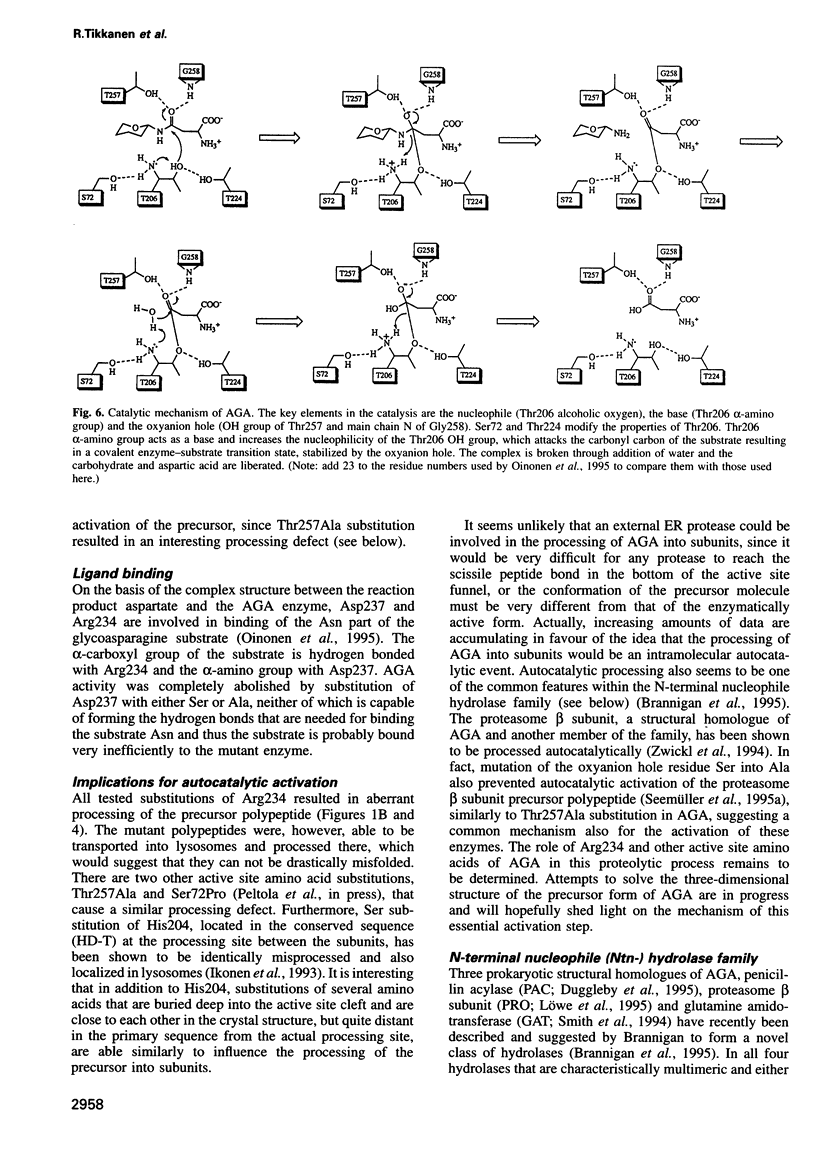
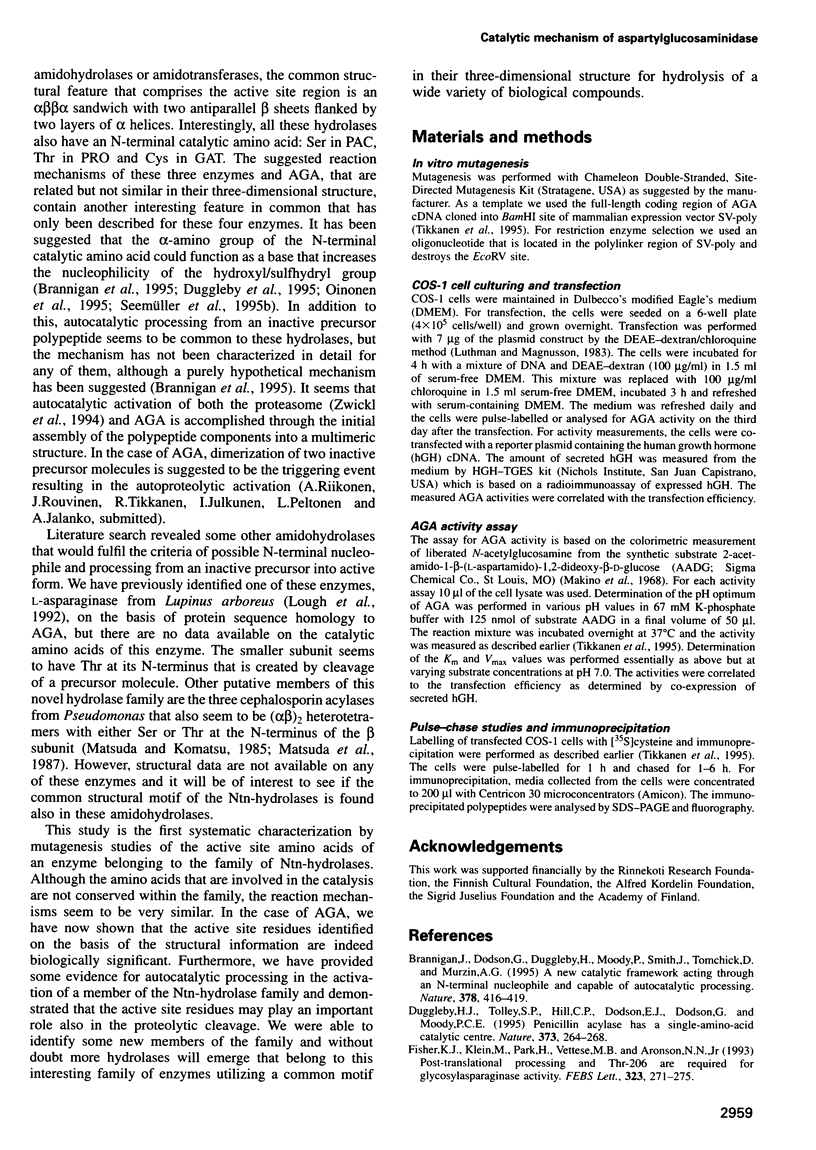
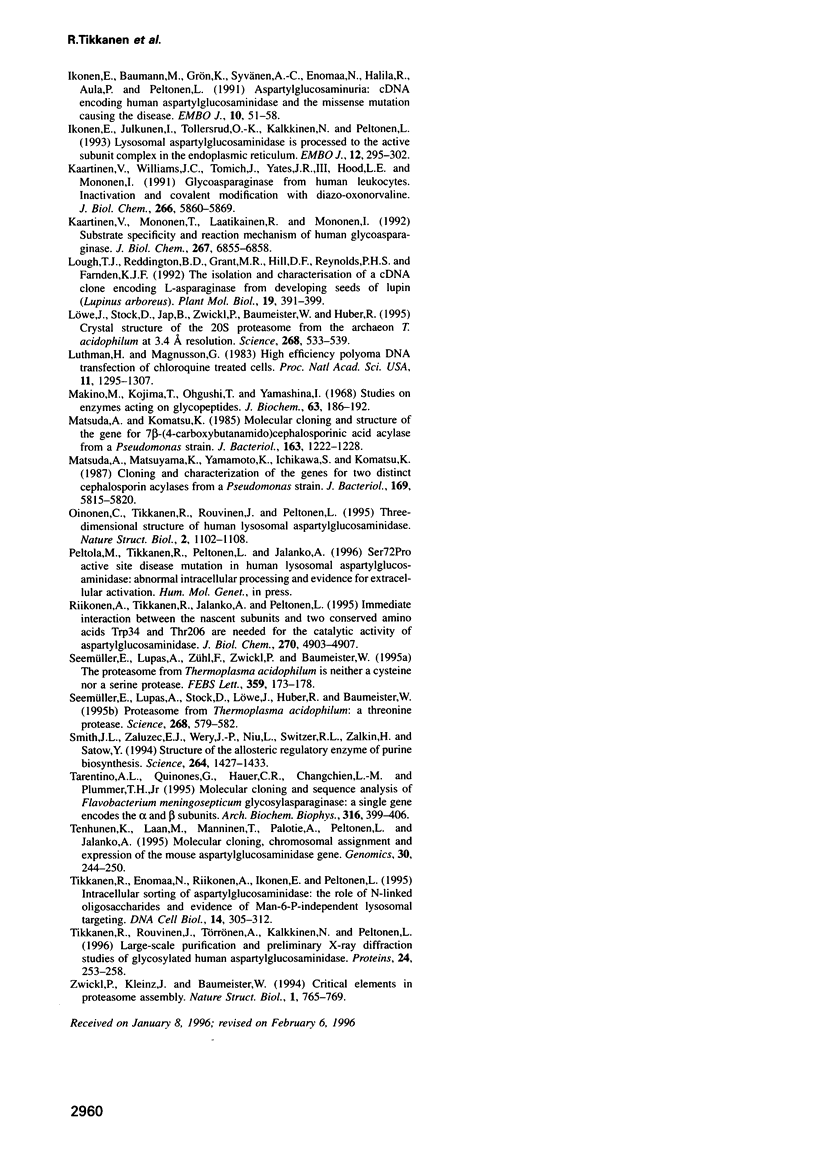
Images in this article
Selected References
These references are in PubMed. This may not be the complete list of references from this article.
- Brannigan J. A., Dodson G., Duggleby H. J., Moody P. C., Smith J. L., Tomchick D. R., Murzin A. G. A protein catalytic framework with an N-terminal nucleophile is capable of self-activation. Nature. 1995 Nov 23;378(6555):416–419. doi: 10.1038/378416a0. [DOI] [PubMed] [Google Scholar]
- Duggleby H. J., Tolley S. P., Hill C. P., Dodson E. J., Dodson G., Moody P. C. Penicillin acylase has a single-amino-acid catalytic centre. Nature. 1995 Jan 19;373(6511):264–268. doi: 10.1038/373264a0. [DOI] [PubMed] [Google Scholar]
- Fisher K. J., Klein M., Park H., Vettese M. B., Aronson N. N., Jr Post-translational processing and Thr-206 are required for glycosylasparaginase activity. FEBS Lett. 1993 Jun 1;323(3):271–275. doi: 10.1016/0014-5793(93)81355-4. [DOI] [PubMed] [Google Scholar]
- Ikonen E., Baumann M., Grön K., Syvänen A. C., Enomaa N., Halila R., Aula P., Peltonen L. Aspartylglucosaminuria: cDNA encoding human aspartylglucosaminidase and the missense mutation causing the disease. EMBO J. 1991 Jan;10(1):51–58. doi: 10.1002/j.1460-2075.1991.tb07920.x. [DOI] [PMC free article] [PubMed] [Google Scholar]
- Ikonen E., Julkunen I., Tollersrud O. K., Kalkkinen N., Peltonen L. Lysosomal aspartylglucosaminidase is processed to the active subunit complex in the endoplasmic reticulum. EMBO J. 1993 Jan;12(1):295–302. doi: 10.1002/j.1460-2075.1993.tb05656.x. [DOI] [PMC free article] [PubMed] [Google Scholar]
- Kaartinen V., Mononen T., Laatikainen R., Mononen I. Substrate specificity and reaction mechanism of human glycoasparaginase. The N-glycosidic linkage of various glycoasparagines is cleaved through a reaction mechanism similar to L-asparaginase. J Biol Chem. 1992 Apr 5;267(10):6855–6858. [PubMed] [Google Scholar]
- Kaartinen V., Williams J. C., Tomich J., Yates J. R., 3rd, Hood L. E., Mononen I. Glycosaparaginase from human leukocytes. Inactivation and covalent modification with diazo-oxonorvaline. J Biol Chem. 1991 Mar 25;266(9):5860–5869. [PubMed] [Google Scholar]
- Lough T. J., Reddington B. D., Grant M. R., Hill D. F., Reynolds P. H., Farnden K. J. The isolation and characterisation of a cDNA clone encoding L-asparaginase from developing seeds of lupin (Lupinus arboreus). Plant Mol Biol. 1992 Jun;19(3):391–399. doi: 10.1007/BF00023386. [DOI] [PubMed] [Google Scholar]
- Luthman H., Magnusson G. High efficiency polyoma DNA transfection of chloroquine treated cells. Nucleic Acids Res. 1983 Mar 11;11(5):1295–1308. doi: 10.1093/nar/11.5.1295. [DOI] [PMC free article] [PubMed] [Google Scholar]
- Löwe J., Stock D., Jap B., Zwickl P., Baumeister W., Huber R. Crystal structure of the 20S proteasome from the archaeon T. acidophilum at 3.4 A resolution. Science. 1995 Apr 28;268(5210):533–539. doi: 10.1126/science.7725097. [DOI] [PubMed] [Google Scholar]
- Makino M., Kojima T., Ohgushi T., Yamashina I. Studies on enzymes acting on glycopeptides. J Biochem. 1968 Feb;63(2):186–192. doi: 10.1093/oxfordjournals.jbchem.a128760. [DOI] [PubMed] [Google Scholar]
- Matsuda A., Komatsu K. I. Molecular cloning and structure of the gene for 7 beta-(4-carboxybutanamido)cephalosporanic acid acylase from a Pseudomonas strain. J Bacteriol. 1985 Sep;163(3):1222–1228. doi: 10.1128/jb.163.3.1222-1228.1985. [DOI] [PMC free article] [PubMed] [Google Scholar]
- Matsuda A., Matsuyama K., Yamamoto K., Ichikawa S., Komatsu K. Cloning and characterization of the genes for two distinct cephalosporin acylases from a Pseudomonas strain. J Bacteriol. 1987 Dec;169(12):5815–5820. doi: 10.1128/jb.169.12.5815-5820.1987. [DOI] [PMC free article] [PubMed] [Google Scholar]
- Oinonen C., Tikkanen R., Rouvinen J., Peltonen L. Three-dimensional structure of human lysosomal aspartylglucosaminidase. Nat Struct Biol. 1995 Dec;2(12):1102–1108. doi: 10.1038/nsb1295-1102. [DOI] [PubMed] [Google Scholar]
- Riikonen A., Tikkanen R., Jalanko A., Peltonen L. Immediate interaction between the nascent subunits and two conserved amino acids Trp34 and Thr206 are needed for the catalytic activity of aspartylglucosaminidase. J Biol Chem. 1995 Mar 3;270(9):4903–4907. doi: 10.1074/jbc.270.9.4903. [DOI] [PubMed] [Google Scholar]
- Seemüller E., Lupas A., Stock D., Löwe J., Huber R., Baumeister W. Proteasome from Thermoplasma acidophilum: a threonine protease. Science. 1995 Apr 28;268(5210):579–582. doi: 10.1126/science.7725107. [DOI] [PubMed] [Google Scholar]
- Seemüller E., Lupas A., Zühl F., Zwickl P., Baumeister W. The proteasome from Thermoplasma acidophilum is neither a cysteine nor a serine protease. FEBS Lett. 1995 Feb 13;359(2-3):173–178. doi: 10.1016/0014-5793(95)00036-9. [DOI] [PubMed] [Google Scholar]
- Smith J. L., Zaluzec E. J., Wery J. P., Niu L., Switzer R. L., Zalkin H., Satow Y. Structure of the allosteric regulatory enzyme of purine biosynthesis. Science. 1994 Jun 3;264(5164):1427–1433. doi: 10.1126/science.8197456. [DOI] [PubMed] [Google Scholar]
- Tarentino A. L., Quinones G., Hauer C. R., Changchien L. M., Plummer T. H., Jr Molecular cloning and sequence analysis of Flavobacterium meningosepticum glycosylasparaginase: a single gene encodes the alpha and beta subunits. Arch Biochem Biophys. 1995 Jan 10;316(1):399–406. doi: 10.1006/abbi.1995.1053. [DOI] [PubMed] [Google Scholar]
- Tenhunen K., Laan M., Manninen T., Palotie A., Peltonen L., Jalanko A. Molecular cloning, chromosomal assignment, and expression of the mouse aspartylglucosaminidase gene. Genomics. 1995 Nov 20;30(2):244–250. doi: 10.1006/geno.1995.9881. [DOI] [PubMed] [Google Scholar]
- Tikkanen R., Enomaa N., Riikonen A., Ikonen E., Peltonen L. Intracellular sorting of aspartylglucosaminidase: the role of N-linked oligosaccharides and evidence of Man-6-P-independent lysosomal targeting. DNA Cell Biol. 1995 Apr;14(4):305–312. doi: 10.1089/dna.1995.14.305. [DOI] [PubMed] [Google Scholar]
- Tikkanen R., Rouvinen J., Törrönen A., Kalkkinen N., Peltonen L. Large-scale purification and preliminary x-ray diffraction studies of human aspartylglucosaminidase. Proteins. 1996 Feb;24(2):253–258. doi: 10.1002/(SICI)1097-0134(199602)24:2<253::AID-PROT12>3.0.CO;2-M. [DOI] [PubMed] [Google Scholar]
- Zwickl P., Kleinz J., Baumeister W. Critical elements in proteasome assembly. Nat Struct Biol. 1994 Nov;1(11):765–770. doi: 10.1038/nsb1194-765. [DOI] [PubMed] [Google Scholar]






